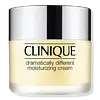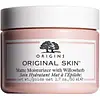What's inside
What's inside
 Key Ingredients
Key Ingredients

 Benefits
Benefits

 Concerns
Concerns

No concerns
 Ingredients Side-by-side
Ingredients Side-by-side

Water
Skin ConditioningGlycerin
HumectantDimethicone
EmollientPetrolatum
EmollientTridecyl Stearate
EmollientTridecyl Trimellitate
EmollientPolyglyceryl-10 Pentastearate
Skin ConditioningBehenyl Alcohol
EmollientDipentaerythrityl Hexacaprylate/Hexacaprate
EmulsifyingCucumis Sativus Fruit Extract
EmollientHordeum Vulgare Extract
EmollientSodium Stearoyl Lactylate
EmulsifyingCaprylyl Glycol
EmollientPropylene Glycol Dicaprate
EmollientHelianthus Annuus Seedcake
AbrasivePEG-100 Stearate
Sodium Hyaluronate
HumectantCetyl Alcohol
EmollientButylene Glycol
HumectantTromethamine
BufferingCarbomer
Emulsion StabilisingPhenoxyethanol
PreservativeCI 19140
Cosmetic ColorantCI 15985
Cosmetic ColorantCI 17200
Cosmetic ColorantWater, Glycerin, Dimethicone, Petrolatum, Tridecyl Stearate, Tridecyl Trimellitate, Polyglyceryl-10 Pentastearate, Behenyl Alcohol, Dipentaerythrityl Hexacaprylate/Hexacaprate, Cucumis Sativus Fruit Extract, Hordeum Vulgare Extract, Sodium Stearoyl Lactylate, Caprylyl Glycol, Propylene Glycol Dicaprate, Helianthus Annuus Seedcake, PEG-100 Stearate, Sodium Hyaluronate, Cetyl Alcohol, Butylene Glycol, Tromethamine, Carbomer, Phenoxyethanol, CI 19140, CI 15985, CI 17200
Water
Skin ConditioningDimethicone
EmollientAlcohol Denat.
AntimicrobialGlycerin
HumectantSilica
AbrasiveButylene Glycol
HumectantCitrus Aurantium Dulcis Peel Oil
MaskingCitrus Limon Peel Oil
MaskingPelargonium Graveolens Flower Oil
MaskingLavandula Angustifolia Oil
MaskingAmyris Balsamifera Bark Oil
MaskingCitrus Aurantium Bergamia Fruit Oil
MaskingEugenia Caryophyllus Leaf Oil
MaskingRosa Damascena Flower Oil
MaskingEucalyptus Globulus Leaf Oil
PerfumingZingiber Officinale Root Oil
MaskingMentha Viridis Leaf Oil
AstringentLimonene
PerfumingLinalool
PerfumingCitronellol
PerfumingCitral
PerfumingGeraniol
PerfumingEugenol
PerfumingDimethicone Crosspolymer
Emulsion StabilisingAmmonium Acryloyldimethyltaurate/Vp Copolymer
Pyrus Malus Fruit Extract
Skin ConditioningCucumis Sativus Fruit Extract
EmollientEpilobium Angustifolium Flower/Leaf/Stem Extract
Skin ConditioningCistus Incanus Flower/Leaf/Stem Extract
Skin ConditioningSucrose
HumectantBambusa Vulgaris Extract
Skin ConditioningPisum Sativum Extract
Skin ConditioningCastanea Sativa Seed Extract
Skin ConditioningAlbizia Julibrissin Bark Extract
MaskingSalicylic Acid
MaskingCaffeine
Skin ConditioningArginine
MaskingSodium Hyaluronate
HumectantScutellaria Baicalensis Root Extract
AstringentLaminaria Saccharina Extract
Skin ProtectingLaminaria Digitata Extract
Skin ProtectingPhospholipids
Skin ConditioningHydrolyzed Jojoba Esters
Skin ConditioningGlucosamine Hcl
Lauryl PEG-9 Polydimethylsiloxyethyl Dimethicone
Skin ConditioningDimethicone/Vinyl Dimethicone Crosspolymer
Skin ConditioningCaprylyl Glycol
EmollientAcrylates/C10-30 Alkyl Acrylate Crosspolymer
Emulsion StabilisingTocopheryl Acetate
AntioxidantTromethamine
BufferingSilica Silylate
EmollientHexylene Glycol
EmulsifyingSodium Polyacrylate
AbsorbentDisodium EDTA
Phenoxyethanol
PreservativeMica
Cosmetic ColorantCI 77891
Cosmetic ColorantCI 77491
Cosmetic ColorantWater, Dimethicone, Alcohol Denat., Glycerin, Silica, Butylene Glycol, Citrus Aurantium Dulcis Peel Oil, Citrus Limon Peel Oil, Pelargonium Graveolens Flower Oil, Lavandula Angustifolia Oil, Amyris Balsamifera Bark Oil, Citrus Aurantium Bergamia Fruit Oil, Eugenia Caryophyllus Leaf Oil, Rosa Damascena Flower Oil, Eucalyptus Globulus Leaf Oil, Zingiber Officinale Root Oil, Mentha Viridis Leaf Oil, Limonene, Linalool, Citronellol, Citral, Geraniol, Eugenol, Dimethicone Crosspolymer, Ammonium Acryloyldimethyltaurate/Vp Copolymer, Pyrus Malus Fruit Extract, Cucumis Sativus Fruit Extract, Epilobium Angustifolium Flower/Leaf/Stem Extract, Cistus Incanus Flower/Leaf/Stem Extract, Sucrose, Bambusa Vulgaris Extract, Pisum Sativum Extract, Castanea Sativa Seed Extract, Albizia Julibrissin Bark Extract, Salicylic Acid, Caffeine, Arginine, Sodium Hyaluronate, Scutellaria Baicalensis Root Extract, Laminaria Saccharina Extract, Laminaria Digitata Extract, Phospholipids, Hydrolyzed Jojoba Esters, Glucosamine Hcl, Lauryl PEG-9 Polydimethylsiloxyethyl Dimethicone, Dimethicone/Vinyl Dimethicone Crosspolymer, Caprylyl Glycol, Acrylates/C10-30 Alkyl Acrylate Crosspolymer, Tocopheryl Acetate, Tromethamine, Silica Silylate, Hexylene Glycol, Sodium Polyacrylate, Disodium EDTA, Phenoxyethanol, Mica, CI 77891, CI 77491
 Reviews
Reviews

Ingredients Explained
These ingredients are found in both products.
Ingredients higher up in an ingredient list are typically present in a larger amount.
Butylene Glycol (or BG) is used within cosmetic products for a few different reasons:
Overall, Butylene Glycol is a safe and well-rounded ingredient that works well with other ingredients.
Though this ingredient works well with most skin types, some people with sensitive skin may experience a reaction such as allergic rashes, closed comedones, or itchiness.
Learn more about Butylene GlycolCaprylyl Glycol is a humectant and emollient, meaning it attracts and preserves moisture.
It is a common ingredient in many products, especially those designed to hydrate skin. The primary benefits are retaining moisture, skin softening, and promoting a healthy skin barrier.
Though Caprylyl Glycol is an alcohol derived from fatty acids, it is not the kind that can dry out skin.
This ingredient is also used as a preservative to extend the life of products. It has slight antimicrobial properties.
Learn more about Caprylyl GlycolThis extract comes from cucumber. Cucumbers are mostly made up of water (95%), and the other 5% is composed of: vitamin C, caffeic acid, fatty acids, amino acids, and other minerals.
Cucumbers have anti-inflammatory, barrier repair, and hydrating properties.
They contain shikimate dehydrigenase, an enzyme shown to help reduce inflammation and soothe the skin.
The amino acids found in cucumbers help nourish our skin's natural acid mantle (it's an important part of our skin barrier). This slightly acidic film acts as a barrier to protect us from bacteria, viruses, and other contaminants.
Unless you have an allergy to cucumbers, this is generally a non-irritating ingredient.
Fun fact: Cucumis Sativus is native to South Asia and can now be found on every continent.
Learn more about Cucumis Sativus Fruit ExtractDimethicone is a type of synthetic silicone created from natural materials such as quartz.
What it does:
Dimethicone comes in different viscosities:
Depending on the viscosity, dimethicone has different properties.
Ingredients lists don't always show which type is used, so we recommend reaching out to the brand if you have questions about the viscosity.
This ingredient is unlikely to cause irritation because it does not get absorbed into skin. However, people with silicone allergies should be careful about using this ingredient.
Note: Dimethicone may contribute to pilling. This is because it is not oil or water soluble, so pilling may occur when layered with products. When mixed with heavy oils in a formula, the outcome is also quite greasy.
Learn more about DimethiconeGlycerin is already naturally found in your skin. It helps moisturize and protect your skin.
A study from 2016 found glycerin to be more effective as a humectant than AHAs and hyaluronic acid.
As a humectant, it helps the skin stay hydrated by pulling moisture to your skin. The low molecular weight of glycerin allows it to pull moisture into the deeper layers of your skin.
Hydrated skin improves your skin barrier; Your skin barrier helps protect against irritants and bacteria.
Glycerin has also been found to have antimicrobial and antiviral properties. Due to these properties, glycerin is often used in wound and burn treatments.
In cosmetics, glycerin is usually derived from plants such as soybean or palm. However, it can also be sourced from animals, such as tallow or animal fat.
This ingredient is organic, colorless, odorless, and non-toxic.
Glycerin is the name for this ingredient in American English. British English uses Glycerol/Glycerine.
Learn more about GlycerinPhenoxyethanol is a preservative that has germicide, antimicrobial, and aromatic properties. Studies show that phenoxyethanol can prevent microbial growth. By itself, it has a scent that is similar to that of a rose.
It's often used in formulations along with Caprylyl Glycol to preserve the shelf life of products.
Sodium Hyaluronate is hyaluronic acid's salt form. It is commonly derived from the sodium salt of hyaluronic acid.
Like hyaluronic acid, it is great at holding water and acts as a humectant. This makes it a great skin hydrating ingredient.
Sodium Hyaluronate is naturally occurring in our bodies and is mostly found in eye fluid and joints.
These are some other common types of Hyaluronic Acid:
Learn more about Sodium HyaluronateTromethamine helps balance the pH and improve the texture of a product. It is synthetically created.
As an emulsifier, Tromethamine prevents oil and water ingredients from separating. This helps stabilize the product and elongate a product's shelf life. Tromethamine also makes a product thicker.
Tromethamine helps balance the pH level of a product. Normal pH level of skin is slightly acidic (~4.75-5.5). The acidity of our skin is maintained by our glands and skin biome. Being slightly acidic allows our skin to create an "acid mantle". This acid mantle is a thin barrier that protects our skin from bacteria and contaminants.
Oral Tromethanmine is an anti-inflammatory drug but plays the role of masking, adding fragrance, and/or balancing pH in skincare.
1,3-Propanediol, 2-amino-2-(hydroxymethyl)-
Learn more about TromethamineWater. It's the most common cosmetic ingredient of all. You'll usually see it at the top of ingredient lists, meaning that it makes up the largest part of the product.
So why is it so popular? Water most often acts as a solvent - this means that it helps dissolve other ingredients into the formulation.
You'll also recognize water as that liquid we all need to stay alive. If you see this, drink a glass of water. Stay hydrated!
Learn more about Water